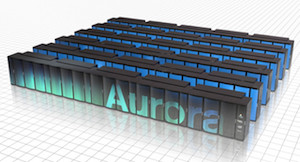 In this Tech Shift podcast, Michael Papka and Susan Coghlan from Argonne National Laboratory discuss the 180 Petaflop Aurora supercomputer scheduled for deployment in 2018. Powered by third-generation Intel Xeon Phi processors, the Cray system will be a significant leap towards Exascale computing.
In this Tech Shift podcast, Michael Papka and Susan Coghlan from Argonne National Laboratory discuss the 180 Petaflop Aurora supercomputer scheduled for deployment in 2018. Powered by third-generation Intel Xeon Phi processors, the Cray system will be a significant leap towards Exascale computing.
Aurora is the Argonne Leadership Computing Facility’s next big advancement in supercomputing. Designed in collaboration with industry leaders Intel and Cray and operated in support of open science as part of the U.S. Department of Energy’s Leadership Computing Facility, Aurora is a next-generation system for computational science and engineering. Aurora exists for the exclusive use of the scientific and engineering research community—a global and growing community whose unbounded curiosity drives the breakthroughs that benefit humanity the most. From finding alternative energy sources to treating diseases to developing high-tech materials—the research done on leadership-class machines yields the world’s biggest technological advancements. These machines also serve to advance our understanding of our physical world, visible and invisible, the terrestrial and to galaxies far beyond our own. Aurora will deliver more than eighteen times the computational performance of Mira, its predecessor at the ALCF, using a nearly equal number of compute nodes. Aurora will be a many-core system—but with nearly an order of magnitude more processors.
See our full coverage of the Aurora supercomputer announcement. * Sign up for our insideHPC Newsletter.




